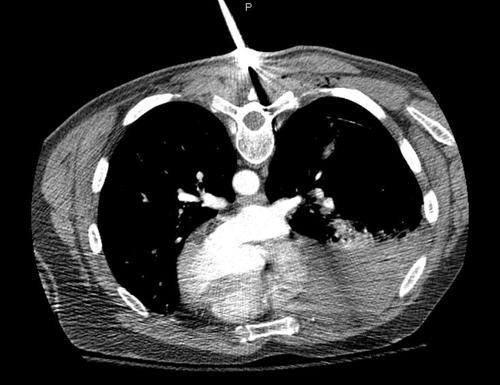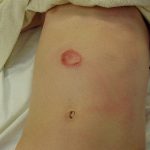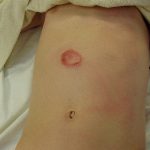To summarize: stab to the back, prone position, stable vitals, awake and alert and breathing easily. The patient had a chest xray which showed some likely hemothorax. He was sent to CT (prone) and the image obtained looked like this:

They key points to note are:
- The injury is completely above the diaphragm. No need to worry about an intra-abdominal problem.
- The amount of hemothorax is moderate. It is not enough to mandate a thoracotomy. At least for now.
- There is a significant pneumothorax. You can’t see it due to the windows used, but the lung has separated from the chest wall by about 3cm.
- The track of the knife was directed laterally.
- No significant vascular structures were involved, and there is no contrast extravasation.
Final management: The patient was returned to the ED, and the knife was deftly removed and processed properly as evidence. The patient was then turned supine and a 40 Fr chest tube was inserted using procedural sedation. About 400 cc of blood was drained and reinfused. A repeat chest xray was obtained, which showed some residual hemothorax and near resolution of the pneumothorax. He was then admitted for frequent vital signs and drainage measurements for two shifts. Afterwards, he was placed in our chest tube management protocol. The tube was removed and he was discharged two days later. There were no complications.
Figure It Out! The Answer
Several readers emailed the correct answer yesterday. The picture is a child with a bicycle handlebar injury to the epigastrium. The plastic grip over the end of the handlebar has a small hole in the middle leaving the distinctive mark seen in the photo.
Children are more likely to sustain significant injuries from this mechanism because they have little muscle in their abdominal wall, so it can’t protect as well as it does in adults. Everything between the handlebar and the spine gets crushed together, frequently resulting in serious injury.
Possible injuries include:
- Pancreatic injury / transection
- Liver laceration (left lobe)
- Duodenal injury / hematoma
- Retrohepatic vena cava injury
I’ve listed them in what I believe to be the usual order. The literature varies a bit because there aren’t a lot of series published. In this case, the injury was a pancreatic transection.
Bottom line: Handlebar injuries in children (and to a lesser degree, adults) are a significant marker for serious abdominal injury. CT scan is mandatory to find the diagnosis. Proper management of a pancreatic injury is a good topic for a future post!
I’ve gotten quite a few emails with guesses about the correct diagnosis in yesterday’s picture, but nobody has figured it out yet.
Here are a few hints:
- It’s a child
- The mark is round with a dot in the middle
- And it’s a child
I’ll give the answer tomorrow. Email or post your guesses below!
Figure It Out!
Here’s a test of your observational skills and trauma knowledge. This picture tells you everything you need to know. What happened, and what’s the likely diagnosis?
Answer tomorrow!
Source: Private archive. Patient not treated at Regions Hospital
Home of the Trauma Professional's Blog




